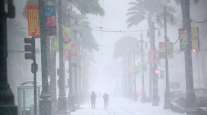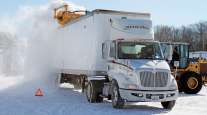Truckers Rely on the Pusher to Get Over California’s Donner Summit

With drought-defying snowstorms romping through the Sierra on a weekly basis, truckers once again are discovering how tough California’s Interstate 80 Donner Pass can be.
Commercial trucks carrying 80,000-pound loads are losing traction in the snow, officials say, even with tire chains on, getting stuck in heavy summit traffic, blocking lanes and threatening to close the highway.
That, officials say, is where the pusher truck comes in.
During a presentation on mountain travel safety this week, Caltrans and the California Trucking Association offered kudos to what they say are quiet mountain heroes this winter. The muscular little rubber-nosed vehicles patrol the mountain during storms, slipping in behind stalled rigs and nudging the commercial trucks forward until the bigger trucks’ wheels can gain enough traction to continue on their own.
The pushers — provided by the trucking association and operated by Caltrans — are part of a multipronged effort by state highway officials to keep one of the major commercial corridors open as often as possible in winter, said Andrew Brandt, deputy director of state highway maintenance and operations.
State officials estimate that 3,500 commercial trucks cross the 7,200-foot summit on I-80 each day, year-round, carrying nearly $5 million worth of goods to market. For experienced truckers, the heavily trafficked summit is a grind in snowstorms as trucks and cars inch along at times in miles-long columns. For inexperienced ones, it’s sometimes frightening.
 Todd Lappin/Flickr
Todd Lappin/Flickr“Running I-80 over Donner Pass in winter season is not for the rookies!” one trucker posted on an online trucking forum. “Donner Pass can be a nightmare.”
Richard Coyle, president of Devine Intermodal, a West Sacramento-based trucking company, said his fleet has computer settings that help improve truck traction, but the mix of cars and trucks over the summit invariably leads to slowdowns that cause trucks to stall, making pusher trucks invaluable.
“I think Caltrans does a remarkable job keeping the (highway) open, but their outreach to people on how to drive in the snow needs to be an ongoing process,” he said.
Eric Sauer, a vice president with the California Trucking Association, said his association is talking with Caltrans and the California Highway Patrol about adding a pusher truck on Interstate 5 at the Dunsmuir grade.
Pusher trucks have been in use off-and-on on I-80 for decades, operating out of the Caltrans Kingvale maintenance yard a few miles west of the summit. Trucking companies once stationed employees in dorms at the Kingvale facility, ready to do pusher duty. It was worth it to avoid private tow truck bills, which could top $1,000 for a stalled commercial truck. But industry cutbacks forced a halt in 2000. In recent years, Caltrans crews have taken up the task, financed by the CTA.
“You really can’t keep the mountain open without them,” Caltrans equipment operator Thomas Annis said.
Annis, of Sacramento, California pulls 12-hour pusher duties during major storms. His truck is small compared to the trucks it pushes, but it is good at getting traction thanks to a two slabs of concrete – 15,000 pounds worth – placed over its rear axle. The truck has a protruding rubber nose that Annis and other pusher drivers nudge up against the rear doors of stalled trucks.
“Trucks usually only need a little bump” to get going, he said. “You idle up behind them, give it a little throttle. You usually get on the radio and tell them, ‘When you’re ready, we’re gonna push.’ ”
@TransportTopics I can't imagine what it would be like to drive a rig over that pass with snow and ice on it. Truck drivers do not get enough credit. — Hey Moe (@Ram09221956) December 27, 2016
The job involves some ingenuity. When traffic is jammed, the pushers may turn and drive against the stalled traffic, if that is the quickest way to get to the next stranded big rig. If one pusher cannot do the job, drivers have used the two pusher trucks, one truck pushing the one that’s pushing the big rig.
Jackknifed big rigs are another puzzle that requires the truck driver and pusher to do some mental geometry and work together to straighten the rig out.
It’s both satisfying and stressful, Annissaid. On bad nights, though, pusher crews will work nonstop. “They’ll shut the road down a minute, and let us clear them out.” he said. At times, the pushers simply go from truck to truck in a frozen queue, unsticking one then another for hours.
“Honestly, we don’t keep count (how many),” he said. “You get them going, then you go get another one.”



